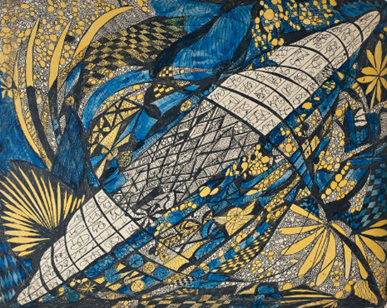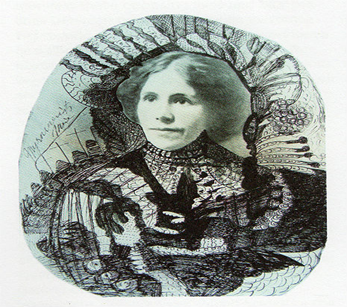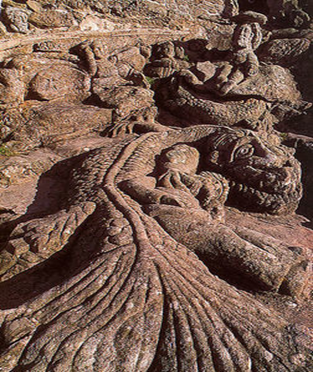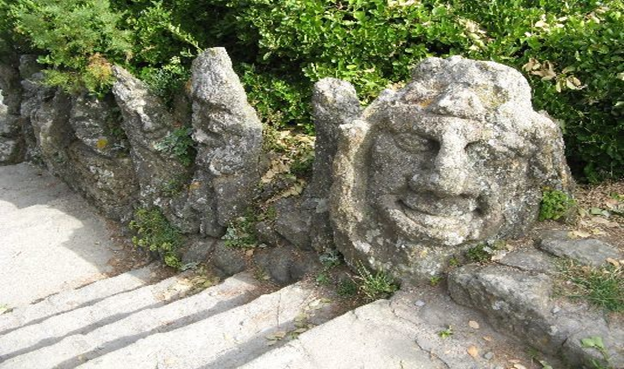Introduction
The contemporary society has seen the focus of the artists shift to modern artistic work. The artists have always demonstrated efficacy in the way the artwork is undertaken and this is essential towards sending the desired message to the respective audience. The creativity of the artists is always manifested in their artwork and they have always been involved in analyzing the historical injustices, certain key events that took place in history, and the change to be expected in the future in the world of art[1]. This has been critical towards engaging the audience and ensuring that the information that is passed across to the audience is positively received. Madge Gill and Abbe Four were the two most influential artists that graced the contemporary art field and offered an understanding of the key trends and the contribution of the key artists in the economy. This essay provides a detailed comparative analysis of the work of Madge Gill and Abbe Foure during their time in the artistic world.
Madge Gill Works
Most of the work undertaken by Madge Gill was based on the guidance of the spirit of Myrninerest in which she believed that it was the reason for having such prolific artistic work during her tenure. Under the influence of this spirit, Madge Gill often had to draw a variety of works using the postcard-sized framework; it was evident that more than 100 drawings were only on a single sitting. The success of Gill’s drawing was based on the assessment of the reality and the activities that Gill was faced in the contemporary live. It was the guidance of this spirit that Madge Gill was able to achieve the current successes that characterizes her. The work of Gill, as illustrated in the figure below, is based extensively on the female faces where it portrays an apparent inner thought of the modern sector initiatives. As the appearance suggests, the occasional words that are evident in the art work often demonstrate the efficacy in the abstract patterns and the way the background information is undertaken with the intention of delivery of the message in the sector. The composition of Gill can be equated to the eye of a draftsman and she relied on the hallucinatory nature and the exquisite delicate nature of her artwork. As such, her work is deemed to be pure abstract and it offers an avenue for the positivity in the assessment process.
It is worth noting that the solitary images of women that are illustrated in the work of Madge Gill are exaggerated and, at the same time, simple in nature. The author relies on open faces and wide eyes with the intention of re-imaging the modern way of living of women and their standardized practice[2]. For instance, as evident in the artistic work of Madge Gill below, the women are hypnotized as images of beauty, and they are characterized by uniqueness in their mode of dressing and their body. The late Victorian dress, as evident in most of the art work that Gill presented, demonstrated the artist’s appreciation of the modern woman. Having outlandish skirts, bonnets, and hats, the images of the women inhibit familiar background that is associated with fashion-centric behavior. Gill escalated her work through considering the development of new measures and strategies that will map her work with the modern trend in the fashion sector. In one of the artwork, Madge Gill articulates to the need of incorporating the new framework that is associated with the music sector through focusing on artistic work that is associated with playing piano. The self portrait of Gill demonstrates the spiritual mindscape through assessing the recognizable reality and focusing on the key inhabitants.
The reality of the artwork of Madge Gill is affected by the abstract pieces that are useful towards achieving a combination of different colors that spells the operations and effectiveness of the activities. Through developing a layout and presenting the empty spaces in most of the artwork of Gill, the intention is to necessitate global success and competitiveness in the economy and the artwork. The background of the artistic work is densely and frenetic patterned and this is essential in increasing the efficiency of the operations and marketing the artwork pieces of Madge Gill. The use of different facial portraits in her work provided an analysis of the attributes of the artist.
Consequently, Gill’s work can be deemed as intriguing and haunting especially with the display that is evident from the artwork that is offered. It is through the work of Gill that the memory of the past activities and experiences in the artistic field is clearly displayed. The literary views on the characteristics and traits of different individuals across the globe are well outlined in the visual representation of the work of Gill. The background and the foreground of the work of Gill are merged and this creates an illusion when the audience views such work. With the seamless insertion of the key features of the colors and the faces of the concerned individuals, the pattern that is written in the hectic space demonstrates the ability of Madge Gill to showcase the artistic talent and invigorate the audience. The colors are blurred in most of the work that is undertaken by the artist and this demonstrates the uniqueness in mixing the intensity of color with the message that is offered to the audience.
When assessing the life of the artist, it is evident that Madge Gill is one of the highly fascinating and hypnotic artists as she always shunned from public life and focused on working privately on her artistic work. The obsessive and the nervousness in the work that she undertook demonstrated her sense of urgency in whatever activities that she undertook. As such, she feared losing control on the life’s context and the work that she undertook. Following the repatriation of Madge Gill from Canada, she believed extensively on the spiritual belief and demonstrated her identity in increasing the efficiency of her work and enhancing competitiveness of the activities. The death of Madge Gill’s children was one of the lowest moments of her life and it changed her perception and views to the contemporary society. Gill was always involved in signing of pictures that were associated with the work and exhibition that she possessed. Through the creation of internal familiar environment and development of key features in the artistic work, Madge Gill strategy was to improve the content that was being delivered to the audience.
Abbe Foure Works
Unlike Madge Gill, Abbe Foure was concerned with carving sculptors with the aim of passing the message to the intended audience. The artist began carving sculptors in the early 1870s and the work of Abbe was fascinating, bizarre, and fascinating. It offered the audience with a wide array of avenues towards understanding the demand in the creative field. The audience believed that the work of Foure was based on skills and hard work, and the message that was passed to the viewers was based on the historical activities and operations in the economy. Abbe was involved in constant assessment and scanning of environment to determine the uniqueness in the way activities are undertaken, and this was crucial in coming up with new ways of cutting a sculptor. The main sources of undertaking the sculptor work were on wood and stones, and it was a daunting task to carve the art work on the stones; a fete that could only be achieved by few individuals.
In addition, Abbe Foure’s work was highly unique and it promoted high quality of art work. The uniqueness in artwork provides an opportunity for the artists to market the artwork and increase the production capacity and the fame in the industry[3]. For instance, Foure was concerned with the carving of legendary adventurers, monsters, smugglers, and fishermen, and this was unique during that era as most of the audiences had not figured out to carve phenomenal carvings from the rocks. One of the standout carvings that can be retrieved from the historical monuments of Abbe Foure is the rock carving of allegorical scenes as evident in the picture below. The use of allegory by the artists was phenomenal in addressing the social injustices and the moral aspects in the 18th century. The super-normal insight that characterized the work of Abbe Foure showed that the artist had deep understanding of the political traits that affected the society. The French revolution was also an issue that changed the perspective of the artists and the focus shifted on the positive trends in the society.
The artists are always characterized by creativity and they should always consider undertaking extreme measures that will yield positive returns in the industry. Some of the elements and the apparatus that Abbe Foure used in the artistic work were all efficient and the content that was utilized was based on the happenings in the society[4]. The creative nature of the artist provided an opportunity for understanding different views in the society regarding key issues that the population is facing. For instance, in the case of the political situation of French, Abbe Foure was concerned with necessitating equity and justice in the way decisions were implemented. This meant that the carving of the sculptors showed the political immorality and the way the inferior society is being subdued. The constant assessment of the environmental activities and the way the government partakes its operations have always been the basis for determining the key traits in the industry. The artist has relied on such information and data in coming up with creative carvings that have been appreciated by the audience.
In addition, the basis of Abbe Foure’s success is based on devotion that he had on the work that he was partaking. Most of his life was involved in carving sculptors and he spent in the shoreline where there was the availability of the soft rock. It is through carving that Abbe Foure relied as a way of getting his daily living; although he always claimed that it was a passion thing and not income generating activity. The strong business knowledge and the creative nature of Abbe Foure artwork was critical in ensuring that the success level in the economy was achieved and it increased the sales volume of the sculptors that the artists sold. Understanding the fragmentation of the artwork industry, Abbe Foure focused on differentiating the artistic work done, and unlike Madge Gill who used painting, the sculptor that was produced by Abbe Foure was long-term and durable. This ensured that the artist was in a better competitive position in the artistic industry as compared to other artists, and his work would continue to dominate the sector even after his demise.
In addition, when considering the work ethics, it is clear that Abbe Foure was concerned extensively on the artistic work and it was clear that the audience would have appreciated the work. The quality of the sculptors that the artists carved was top-notch, and it ensured that the key information and data regarding the activities in the economy were well-managed. Consumers are always appreciative when they purchase or view products of high quality, and Abbe Foure advertised the products offered as those of high quality. When assessing the ermitage, it is evident that the quality of the work that is showcased by the artist supersedes the expectations of the viewers[5]. The stone museum that characterizes the activities of Abbe Foure can be essential for understanding the abilities and key operations in the sector. The hermit carving sits at the foot of the fountain and the way the audience have been visiting the region shows that the sculptor is attractive to all individuals and offers a clear understanding of the cultural perspectives.
When assessing the basic workbench and the interior components of the oak, it offers an opportunity towards understanding the key attributes and the trends in the society. Although some of the work that has been done by the artist might seem to be unfinished, the natural grandeur evident in all the artwork is appealing and is attractive to the audience. This showcases the ability of the artists to utilize on the available materials towards meeting the interest and needs of the audiences[6]. The bench that the sculptors are sitting on is painted and decorated with distinct colors that are very attractive; although the colors have started to fade due to an increase in the harsh climatic conditions and the visitors have increased considerably.
Foure was known for the passion that he demonstrated while working in the museum, and this was unlike other artists that were less appreciative of what they possess. However, after his death, the assets and furniture (including sculptors) that were in his possession were auctioned. The furniture, for instance, was bought by a variety of people of which they took the purchases to art galleries for preservation. Although most of the sculptors that were bought were wooden ones, they did not offer much attractiveness as the case of rock sculptors[7]. As shown in the figure below, Foure always appreciated his museum, and this regard he was seen sitting outside the museum with the intention of marketing the artifacts that are available in the museum. However, following the military invasion during the world war, most of the wooden sculptors vanished, and the only remaining artifacts were the ones carved from the rocks.
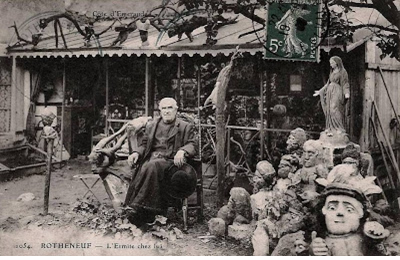
Conclusion
Based on the above comparative analysis of the two artists, it is evident that artistic work is one of the involving duties that require the artist to fully commit to achieving effectiveness and success in the work. It is through the analysis of the work of Madge Gill and Abbe Foure that the creativity and effectiveness in engaging the audience in developing the work is evident. It is worth noting that through focusing on ethical work and high-quality values that the artist can realize success in the artistic work. Madge Gill and Abbe Foure artistic work can be purported to be the pioneers of artistic activities, and the remnants of their work should always be preserved.
Bibliography
Cherbo, Joni Maya, and Vera L. Zolberg. Outsider art: contesting boundaries in contemporary culture, 2007. Cambridge: Cambridge University Press.
Harris, Moira F. Monumental Minnesota: a guide to outdoor sculpture, 2002. New York: Pogo Press.
Rhodes, Colin. Outsider art: spontaneous alternatives, 2010. London: Thames & Hudson.
Tuchman, Maurice, and Carol S. Eliel. Parallel visions: modern artists and outsider art, 2002. Los Angeles, Calif: Los Angeles County Museum of Art.
Peachy Essay essay services provides a wide range of writing help including book and film reviews. Students working on case studies or might need academic help, might find our custom Case Studies Writing Services helpful.






